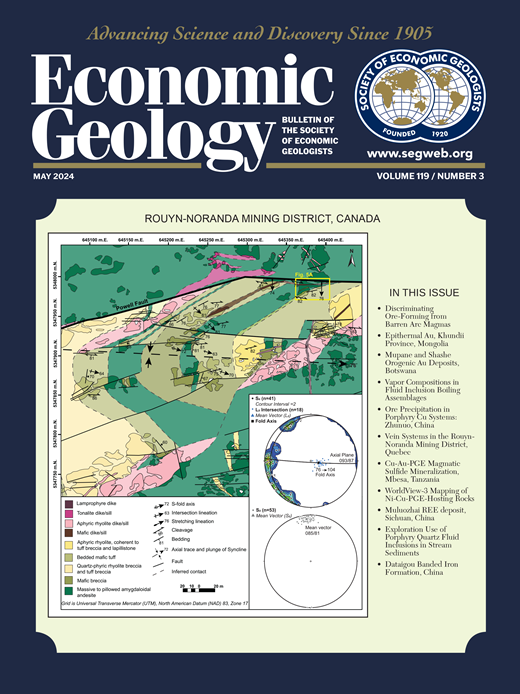阿根廷巴塔哥尼亚纳维达地区Loma Galena铅银矿床的成因:一个由缺氧湖覆盖的独特浅成热液系统
IF 5.5
1区 地球科学
Q1 GEOCHEMISTRY & GEOPHYSICS
引用次数: 0
摘要
Loma Galena (978,852 t Pb, 206moz Ag)是位于阿根廷北部巴塔哥尼亚Cañadón Asfalto大陆前陆盆地的世界级Navidad Pb + Ag±(Zn, Cu)地区的8个浅成热液矿床之一。该盆地形成于侏罗纪,是冈瓦纳分裂时期的伸展构造体系。寄主岩石包括主要的陆面断裂和倾斜的富钾安山岩-英安岩熔岩流块体(173.9 ~ 170.8 Ma);U-Pb年龄(锆石)不整合上覆泥岩,与叠层石和泥质灰岩、砂岩、煤互层,并沉积于湖相环境的富sr蒸发岩层。成矿以展布形式分布在富有机质沉积岩、北西向和北东向正断层上、下盘的脉状和热液角砾岩脉中、火山自角砾岩中以及火山与沉积岩接触处的潜水角砾岩中。最早的热液矿物为胶状、壳状和冠状方解石脉1 (δ13Cfluid -4.7 ~ 0.8‰);δ18Ofluid 4.8 ~ 11.6‰)和菱铁矿。沉淀流体可能是基底交换的盆地盐水,盐度为9.5-16.4 wt % NaCl当量,温度为154.7°-212°C。这些流体与寄主火山岩相互作用,形成方解石、钠长石、阿杜石和青瓷-海绿石群矿物,随着fO2的降低,形成绿泥石和菱铁矿。液体间歇性沸腾,如方解石中片状结构1所示。随后的矿化阶段增加了洛马方铅矿的金属禀赋。富有机质泥岩丰度和硫化物δ34S值在-15.4 ~ 12.9‰,表明湖底水体缺氧,微生物硫酸盐还原位点(蒸发岩δ34S值为35‰)。从深部携带部分S的富金属盆地流体与富硫化氢的原生水混合,有效地在主岩中析出含银的树状黄铁矿、胶状黄铁矿—黄铁矿、黄铜矿、斑铜矿、帘状四面体、闪锌矿和方铅矿等矿脉、角砾岩和浸染物。矿石的品位和吨位最高的是位于最上层熔岩流和上覆泥岩交界处的自角砾岩,在那里,硫化物中添加了强烈的微生物特征。这一事件还导致了蚀变火山岩中岩浆和热液长石和方解石1的部分溶解。成矿后为热液角化作用,连续沉积玉髓(δ18Ofluid 2.6 ~ 4.8‰)、重晶石(δ34S 15.7 ~ 22‰);160.9°-183.8°C;7.7-9.7 wt % NaCl当量),方解石2 (δ18Ofluid -10.2 ~ -3.7‰,58°-95°C;角砾岩和角砾岩中含有1.9 ~ 7.0 wt % NaCl当量)、菱锰矿和石英;火山岩中高岭石(δ18Ofluid 2 ~ 6.2‰)、伊利石-蒙脱石、蒙脱石、碳酸盐岩,含少量玉髓和重晶石;沉积岩中的方解石、玉髓和重晶石。盐度随温度降低而降低,流体的δ18O随时间降低,表明盆地流体与侏罗纪大气水(δ18O−9 ~−5.2‰)混合稀释。Loma方铅矿是在湖底缺氧环境下形成的多金属浅成热液系统的一个独特例子,该系统促进了含银硫化物的有效沉积和保存,从而促成了矿床的大尺寸和较高的品位。本文章由计算机程序翻译,如有差异,请以英文原文为准。
Genesis of the Loma Galena Pb-Ag Deposit, Navidad District, Patagonia, Argentina: A Unique Epithermal System Capped by an Anoxic Lake
Loma Galena (978,852 t Pb, 206 Moz Ag) is one of eight epithermal deposits in the world-class Navidad Pb + Ag ± (Zn, Cu) district located in the Cañadón Asfalto continental foreland basin, northern Patagonia, Argentina. This basin formed during the Jurassic in an extensional tectonic regime during the breakup of Gondwana. Host rocks comprise major listric faulted and tilted blocks of K-rich andesite to dacite lava flows (173.9–170.8 Ma; U-Pb ages for zircon) unconformably overlain by mudstone interbedded with stromatolitic and pisolitic limestones, sandstone, coal, and an Sr-rich evaporite layer deposited in a lacustrine environment. The mineralization occurs as disseminations in the organic-rich sedimentary rocks, in veins and hydrothermal breccia dikes in the hanging walls and footwalls of NW- and NE-striking normal faults, in volcanic autobreccias, and in a phreatic breccia at the contact of volcanic and sedimentary rocks.
The earliest hydrothermal minerals consist of veins of colloform, crustiform, and cockade calcite 1 (δ13Cfluid –4.7 to 0.8‰; δ18Ofluid 4.8–11.6‰) and siderite. The precipitating fluids were likely basement-exchanged basinal brines having salinities of 9.5–16.4 wt % NaCl equiv and temperatures of 154.7°–212°C. The interaction of these fluids with the host volcanic rocks formed calcite, albite, adularia, and celadonite-glauconite-group minerals followed by chlorite and siderite as fO2 decreased. Fluids intermittently boiled, as evidenced by bladed (platy) texture in calcite 1.
Subsequent mineralizing stages contributed to the metal endowment of Loma Galena. The abundance of organic-rich mudstone and δ34S from –15.4 to 12.9‰ for sulfides suggests that the bottom waters of the lake were anoxic and the loci of microbial sulfate reduction (evaporites have δ34S 35‰). Mixing of upflowing metal-rich basinal fluids carrying some S from depth with this H2S-rich connate water efficiently precipitated Ag-bearing framboidal pyrite, colloform pyrite-marcasite, chalcopyrite, bornite, tennantite-tetrahedrite, sphalerite, and galena as veins, breccias, and disseminations in host rocks. The highest grade and tonnage of the ores are found in autobreccias at the junction of the uppermost lava flow and in the overlying mudstone, where the addition of a strong microbial signature is recorded in sulfides. This event also led to partial dissolution of magmatic and hydrothermal feldspar and calcite 1 in the altered volcanic rocks.
Mineralization was followed by hydrothermal brecciation and successive precipitation of chalcedony (δ18Ofluid 2.6–4.8‰), barite (δ34S 15.7–22‰; 160.9°–183.8°C; 7.7–9.7 wt % NaCl equiv), calcite 2 (δ18Ofluid –10.2 to –3.7‰, 58°–95°C; 1.9–7.0 wt % NaCl equiv), strontianite, and quartz in brecciated veins and breccias; kaolinite (δ18Ofluid 2–6.2‰), illite-smectite, smectite, and carbonates with minor chalcedony and barite in the volcanic rocks; and calcite, chalcedony, and barite in the sedimentary rocks. A trend of decreasing salinity with decreasing temperature and lowering δ18O of the fluids with time suggests dilution of the basinal fluids by mixing with Jurassic meteoric water (δ18O −9 to −5.2‰).
Loma Galena is a unique example of a polymetallic epithermal system formed in a sublacustrine anoxic environment that promoted the efficient deposition and preservation of Ag-bearing sulfides, thereby contributing to the large size and relatively high grade of the deposit.
求助全文
通过发布文献求助,成功后即可免费获取论文全文。
去求助
来源期刊

Economic Geology
地学-地球化学与地球物理
CiteScore
10.00
自引率
6.90%
发文量
120
审稿时长
6 months
期刊介绍:
The journal, now published semi-quarterly, was first published in 1905 by the Economic Geology Publishing Company (PUBCO), a not-for-profit company established for the purpose of publishing a periodical devoted to economic geology. On the founding of SEG in 1920, a cooperative arrangement between PUBCO and SEG made the journal the official organ of the Society, and PUBCO agreed to carry the Society''s name on the front cover under the heading "Bulletin of the Society of Economic Geologists". PUBCO and SEG continued to operate as cooperating but separate entities until 2001, when the Board of Directors of PUBCO and the Council of SEG, by unanimous consent, approved a formal agreement of merger. The former activities of the PUBCO Board of Directors are now carried out by a Publications Board, a new self-governing unit within SEG.
 求助内容:
求助内容: 应助结果提醒方式:
应助结果提醒方式:


